Picking out the right flooring for each room in your home can really change how everything feels and functions. Kitchens and bathrooms? They face a lot of moisture, while living rooms see constant foot traffic. The best flooring depends on each room’s conditions—moisture, usage, and even things like radiant heating.
Remember to repin your favorite images!
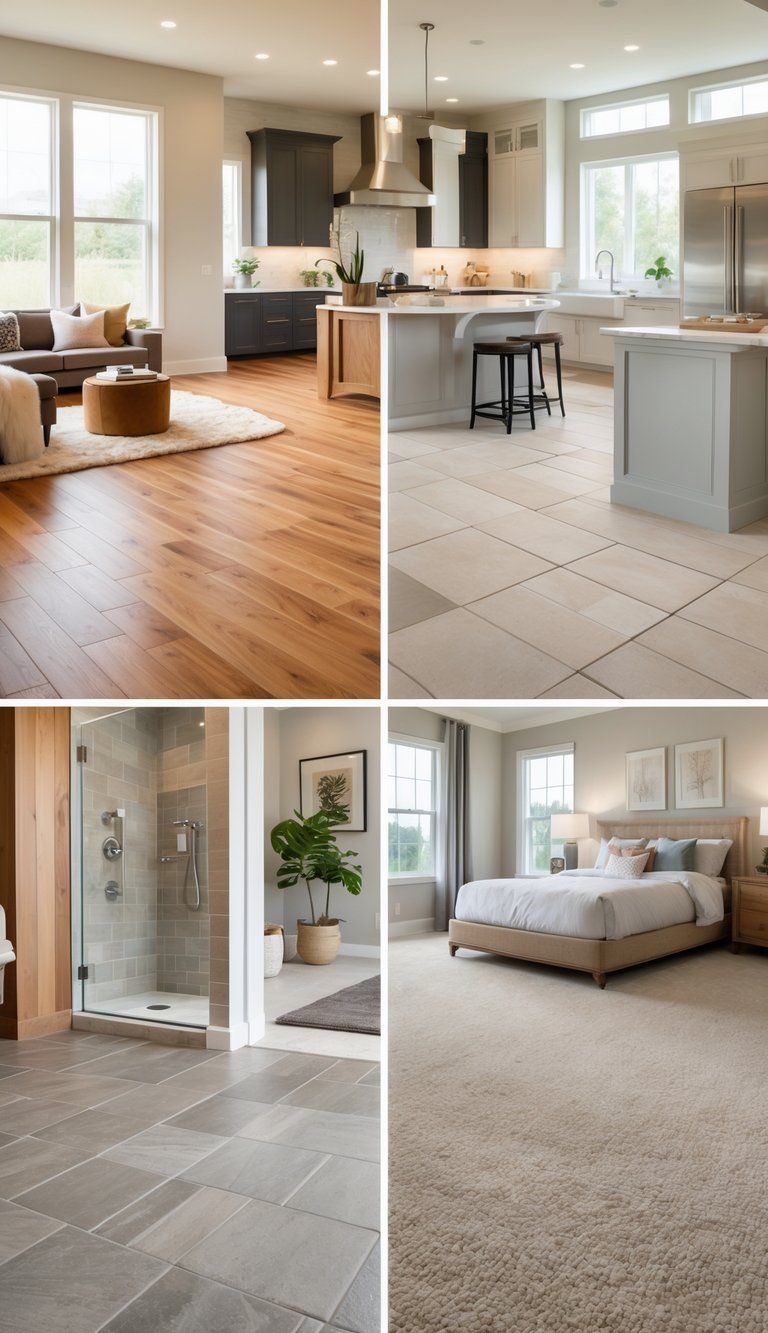
Your flooring choice shapes not just the look but the whole vibe of your home. In bathrooms and kitchens, water-resistant options like vinyl or porcelain tile tend to work best.
For living areas, you might want the coziness of hardwood or something more practical like laminate. Cost matters, too—vinyl can save you around 26 cents per square foot over tile and still look fantastic.
If you’re thinking of DIY installation, you’ll find some materials are friendlier than others. Floating floors like laminate and vinyl plank snap together board by board, so you don’t need to glue them down.
This DIY approach could cut your flooring expense in half and still deliver a great look in any room you choose.
Key Factors in Choosing Flooring Materials
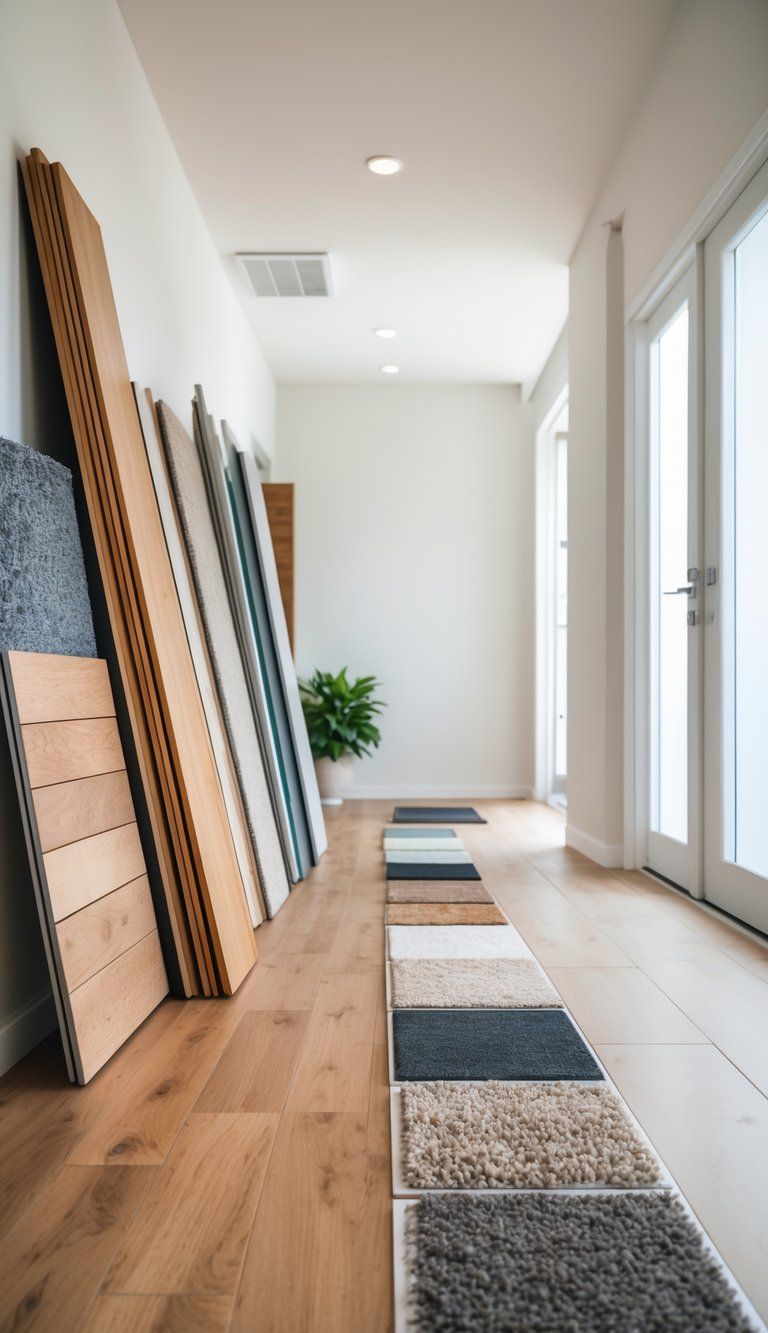
Picking flooring isn’t just about style—it’s about balancing what you need with what you like. You have to weigh several factors that impact both function and feel.
Durability and Lifespan
Durability should come first, especially in busy spots like hallways and living rooms. Every material handles wear and tear differently.
Hardwood can last over 25 years if you take care of it, but it might show scratches if you have pets or kids. Porcelain tile, on the other hand, is super tough—often lasting 50 years or more and resisting scratches and dents.
Luxury vinyl plank (LVP) sits in the middle, lasting around 10-20 years with solid scratch resistance. If you’re flooring a bedroom or a space that doesn’t see much action, carpet could be enough, though it usually lasts only 5-10 years.
Here’s a quick look at durability for common types:
| Flooring Type | Durability Rating | Best For |
|---|---|---|
| Porcelain Tile | Excellent | Bathrooms, kitchens, entryways |
| Hardwood | Very Good | Living rooms, dining rooms |
| LVP/LVT | Good to Very Good | Most rooms, especially with kids/pets |
| Laminate | Good | Bedrooms, offices, living areas |
| Carpet | Fair | Bedrooms, low-traffic areas |
Water Resistance and Moisture Concerns
Water resistance is a must in rooms where spills or moisture are common—think bathrooms, kitchens, and basements. If you pick the wrong material, you might end up with warped floors or even mold.
Ceramic and porcelain tile handle wet environments well and are basically waterproof. Luxury vinyl is also a strong choice for bathrooms and kitchens, thanks to its high water resistance.
Traditional hardwood doesn’t belong in damp areas since it warps and cups easily. Engineered hardwood can handle a little more moisture, but it’s still not great for bathrooms.
For basements, you’ve got a few good moisture-resistant picks:
- Luxury vinyl tile/plank
- Porcelain tile
- Polished concrete
- Certain epoxy flooring systems
Never put carpet in bathrooms or anywhere that might flood. Even so-called “waterproof” carpet can trap moisture underneath and cause mold over time.
Comfort and Insulation
How a floor feels underfoot can really change a room. It also affects temperature and noise.
Carpet tops the list for comfort and insulation. It’s cozy for bedrooms and living rooms, absorbs sound, and stays warm, but it’s not the best if you have allergies.
Hardwood feels moderately comfortable and brings some natural warmth, but it can get noisy unless you add rugs. Cork flooring feels cushioned and gentle on joints, plus it insulates well.
Tile and concrete are tough but can feel cold and hard. If you want to boost comfort, try these ideas:
- Underfloor heating systems
- Area rugs in key spots
- Cork or rubber underlayment under hard flooring
- Thicker vinyl or laminate with padding built in
Everyone’s comfort needs are different. What’s perfect for you might not work for someone else in your house.
Comparing Popular Flooring Types
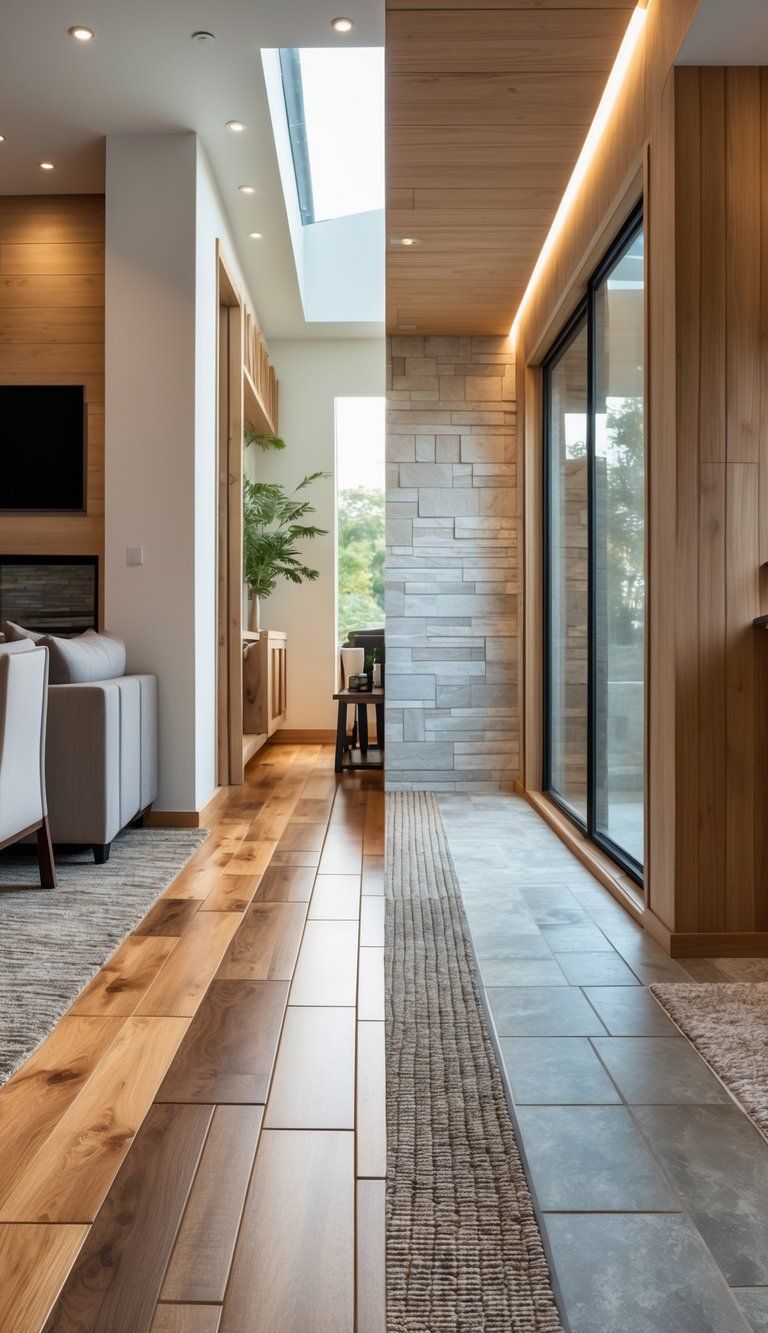
When you’re choosing flooring, you need to know what sets each material apart. Every type brings its own strengths and fits certain rooms and lifestyles better.
Hardwood Flooring Overview
Hardwood floors just have that classic, timeless vibe. Solid hardwood comes from a single piece of wood—usually oak, maple, or walnut. With some care, it can last for generations.
Engineered hardwood handles moisture better than solid wood. It’s made of a real wood top layer glued to plywood, which helps it stay stable in humid spaces.
Hardwood Pros:
- Boosts home value
- Can be refinished several times (especially solid hardwood)
- Warm underfoot and always looks good
Hardwood Cons:
- Scratches and water can damage it
- Costs more ($6-$25 per square foot installed)
- Not great for bathrooms or basements
Vinyl and Luxury Vinyl Options
Vinyl flooring has come a long way. Luxury vinyl plank (LVP) and luxury vinyl tile (LVT) look surprisingly real, whether you want wood or stone vibes.
LVP looks like hardwood planks, while LVT mimics stone or ceramic tile. Both have multiple layers, including a tough wear layer that stands up to scratches and stains.
Vinyl Advantages:
- Totally waterproof (great for bathrooms, kitchens, basements)
- Easy to install (click-lock or peel-and-stick)
- Budget-friendly ($2-$7 per square foot installed)
- Feels warm and comfy underfoot
Most luxury vinyl now comes with textures that match the look, not just the pattern. They’re scratch-resistant and work well if you have pets or kids.
Tile and Stone Flooring
Ceramic and porcelain tiles are super durable and handle moisture like champs. Porcelain is denser and less porous than ceramic, so it’s perfect for heavy use or even outdoors.
Natural stone—think marble, granite, slate, or travertine—brings unique patterns and character you just can’t fake.
Tile and Stone Benefits:
- Incredibly tough and long-lasting
- Water-resistant (ideal for bathrooms)
- Easy to clean
- Pairs well with radiant heating
Installing tile takes some skill. You need to prep the subfloor well to avoid cracks. Stone needs regular sealing to keep it looking good and to prevent stains.
For kitchens and bathrooms, porcelain tile usually offers the best mix of durability and water resistance—without the extra upkeep that natural stone needs.
Flooring Materials by Room
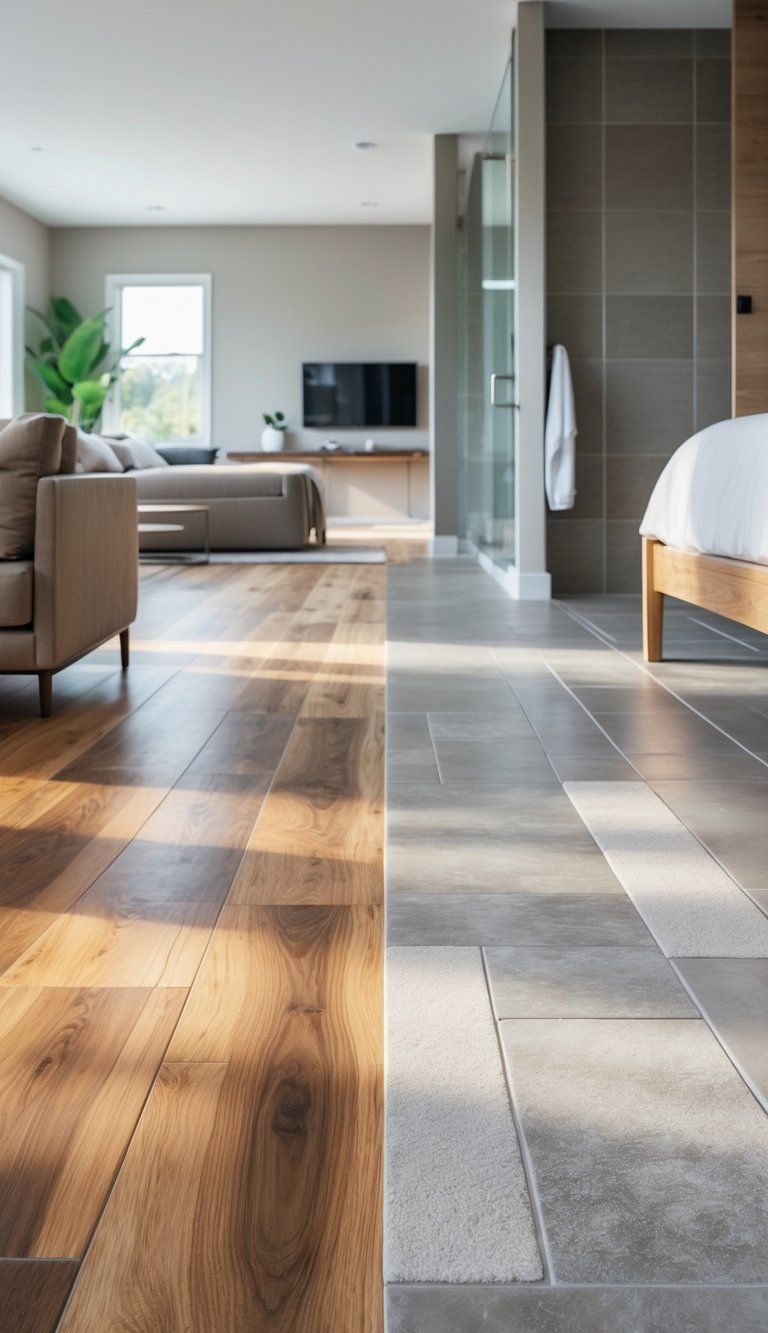
Every room in your house has its own set of needs. Moisture, traffic, and comfort all play a role in what flooring will work best.
Kitchen Flooring
Kitchens take a beating—spills, heavy use, you name it. Ceramic or porcelain tile is a classic pick thanks to its toughness and water resistance. You’ll find tons of styles, and cleanup is a breeze.
Luxury vinyl plank (LVP) is catching on fast in kitchens. It’s waterproof, resists scratches, and feels warmer than tile. People love how LVP looks like hardwood without the moisture worries.
If you’re going for luxury, natural stone like granite or slate has lasting appeal and stands up to wear. Just remember, you’ll need to seal it now and then.
Engineered hardwood can work in kitchens with stable humidity. It gives you that wood look with a bit more moisture protection than solid hardwood.
Bathroom Flooring
Bathrooms need water-resistant floors above everything else. Porcelain tile is a winner—it’s almost waterproof and shrugs off humidity. You can get it in all sorts of sizes and colors, even styles that look like stone or wood.
Luxury vinyl tile (LVT) is another strong choice. It’s waterproof and warmer underfoot than ceramic, which is nice on chilly mornings. LVT installs easily over lots of subfloors.
Natural stone (like marble or travertine) creates a spa vibe but needs regular sealing to avoid water problems. It can also feel cold unless you add radiant heating.
Sheet vinyl is a budget-friendly, waterproof pick for bathrooms. Modern versions look way better than they used to and can even seem upscale.
Living Room Flooring
Living rooms call for comfy, good-looking floors that match your daily life. Hardwood is still the top pick for living spaces. It’s warm, adds value, and can last for years. Oak, maple, and hickory stand up well to foot traffic.
Carpet is unbeatable for comfort and quiet. Today’s carpets include stain-resistant options that handle daily life. Medium-pile carpets in neutral shades work with almost any style.
Luxury vinyl plank gives you a practical, wood-like look with extra scratch and moisture resistance—great if you have kids or pets.
Laminate offers the hardwood look at a lower price. The latest versions resist scratches better and handle moisture more effectively than older ones.
Performance in Special Environments
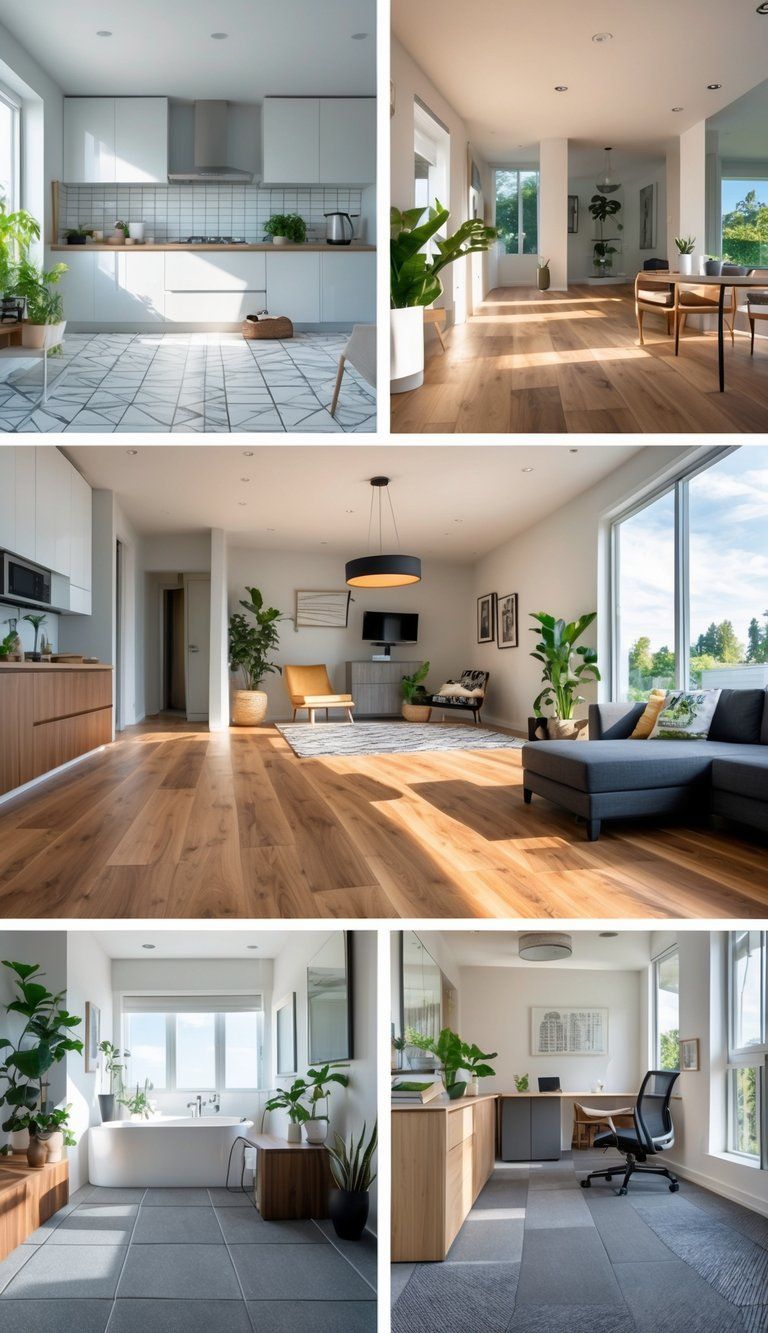
Some rooms just need special flooring. Picking the right material for these spaces can save you from headaches, repairs, and early replacements.
Basements and Below-Grade Areas
Basements can be tricky because of moisture and shifting temperatures. You need floors that won’t warp or get moldy.
Best bets:
- Polished concrete: Tough and naturally resists moisture
- Epoxy coating: Seals concrete for waterproofing
- Luxury vinyl plank: Waterproof and warmer than bare concrete
Concrete floors with epoxy coatings keep moisture from sneaking up through the slab. Plus, epoxy finishes look a lot cooler these days with decorative options.
Skip solid hardwood in basements—it just won’t survive the moisture. If you want a warmer look, try waterproof vinyl that looks like wood. Adding a vapor barrier under any floating floor gives you extra protection.
Laundry and Utility Rooms
Laundry and utility rooms deal with spills, humidity, and cleaning chemicals. You need floors that can handle water and clean up easily.
Good choices:
- Ceramic or porcelain tile: Waterproof and stands up to heavy machines
- Sheet vinyl: Seamless and keeps water out
- Luxury vinyl tile: Water-resistant with fewer seams than planks
Porcelain tile holds up well to water and heavy appliances. Just make sure to seal the grout to keep water from seeping in.
Epoxy coatings are also a solid pick, especially in utility spaces where you need durability. They shrug off chemicals and create a seamless, easy-clean surface.
Whatever you pick, use waterproof adhesives and sealants at the edges to keep water from sneaking underneath.
Cost and Value Considerations
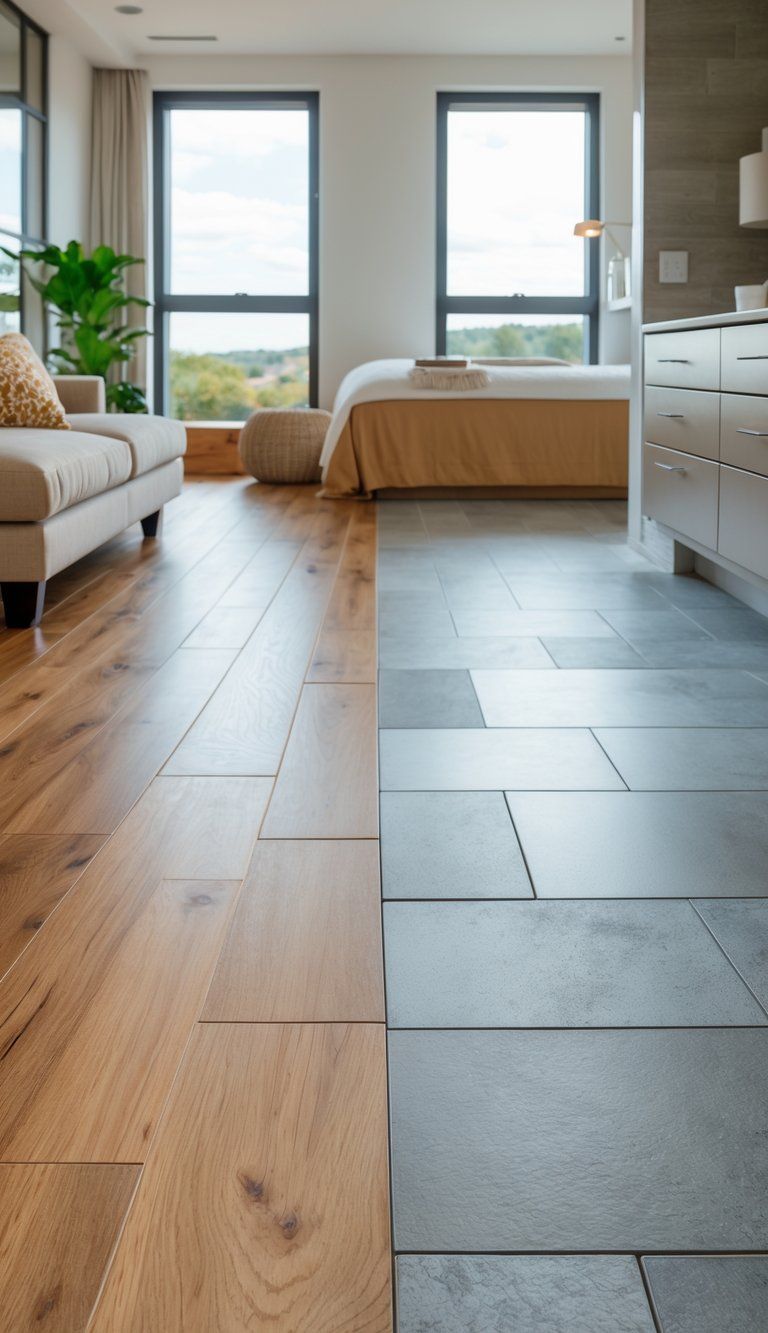
Budget matters—a lot. Flooring prices vary widely, and there’s more to it than just the sticker price. You have to think about installation, long-term value, and how much you’ll actually spend overall.
Material and Installation Costs
Flooring costs can swing a lot depending on what you pick. Vinyl is usually the cheapest, running $2-$7 per square foot with installation. Laminate comes next at $3-$10 per square foot installed.
If you’re looking at mid-range:
- Engineered hardwood: $4-$13 per square foot
- Ceramic tile: $5-$15 per square foot
- Porcelain tile: $6-$20 per square foot
Premium materials will cost you more:
- Solid hardwood: $8-$25 per square foot
- Natural stone: $10-$30 per square foot
Installation prices jump around too. Luxury vinyl planks are pretty DIY-friendly, so you can save some cash. Hardwood or tile usually need a pro, adding $3-$10 per square foot to your bill.
Square footage makes a big difference to your budget. Flooring a small bathroom costs a lot less than a big living room—even with the same material.
Long-Term Maintenance Costs
The real cost of flooring goes way beyond just putting it in. Some materials need a lot of upkeep, which can really add up over time.
Vinyl, laminate, and porcelain tile are pretty easy to live with. Just sweep them regularly and mop once in a while. You probably won’t need to shell out for special cleaners or treatments.
Engineered hardwood and ceramic tile land somewhere in the middle. You might need to reseal them or clean the grout every few years, but that doesn’t usually break the bank.
Solid hardwood, natural stone, and carpet demand more attention. Hardwood floors often need refinishing every 5-10 years, and that can cost $3-$8 per square foot. Carpets? You’ll likely call in the pros for cleaning once a year, which runs $25-$75 per room.
Think about your daily life when weighing these costs. If you have pets or kids, you might actually save money by choosing a slightly pricier but tougher floor, instead of replacing cheaper stuff that gets ruined.
Impact on Resale Value
Flooring can make or break your home’s resale value. The right pick often brings a solid return on investment.
Hardwood flooring usually tops the list for ROI, with 70-80% of its cost coming back at resale. Many buyers will pay extra for homes with hardwood. Even though it’s expensive upfront, it might be worth it for main living spaces.
Tile flooring works well in bathrooms and kitchens. Buyers expect it in places that get wet, and old or dingy floors can really hurt your offers.
Carpet brings the lowest return. It’s affordable, but most buyers see it as personal and plan to replace it anyway.
Your neighborhood plays a role too. In high-end areas, buyers might expect premium stone or fancy hardwood. In more average neighborhoods, engineered hardwood or good laminate usually does the trick.
Match your flooring investment to how long you plan to stay. If you’re sticking around for a decade or more, pick something you genuinely like. If not, go for materials that will appeal to the most buyers.
Aesthetic and Style Choices
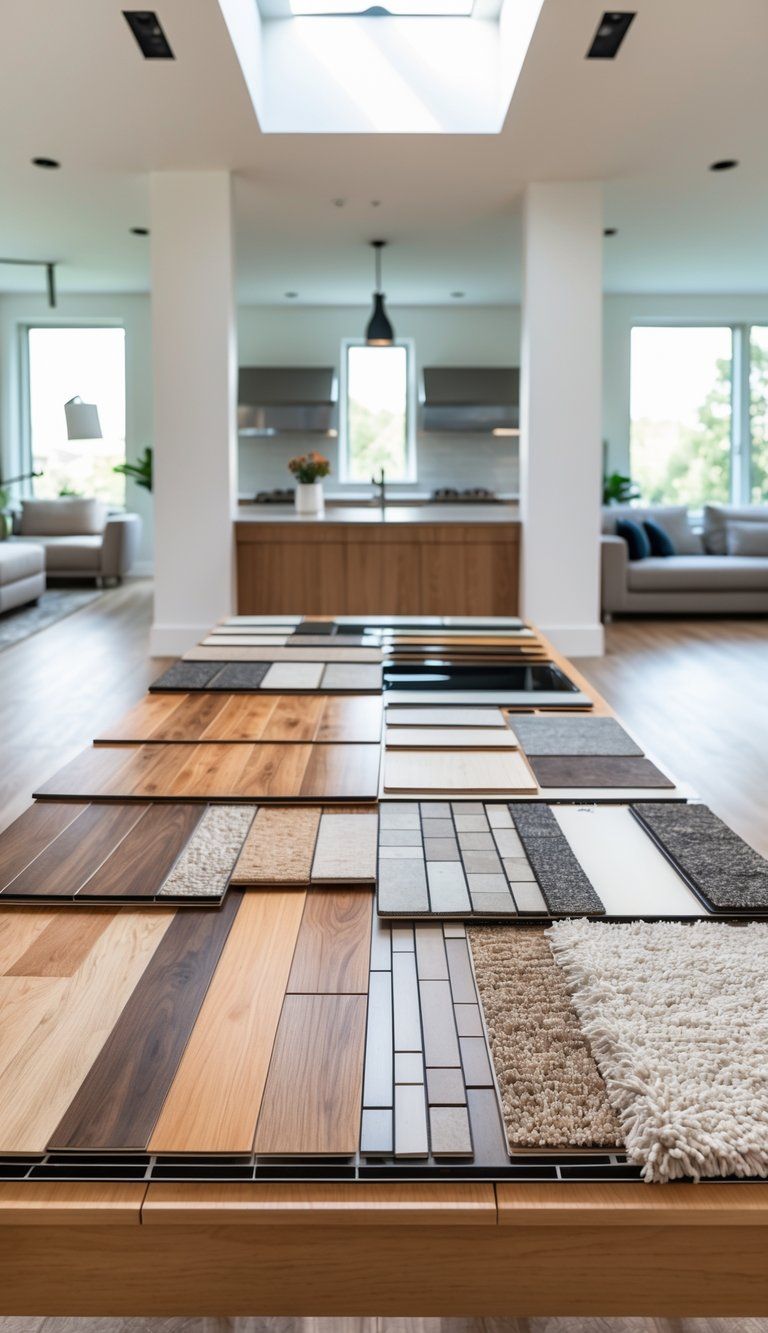
Flooring isn’t just about holding up—it shapes the whole vibe of your place. The right floor can pull a room together and show off your personal style with color, texture, and pattern.
Color, Pattern, and Texture
Floor color sets the mood. Light floors make rooms feel bigger and brighter, while dark floors add coziness and depth. Got good natural light? Most colors look great. If your space is a bit dim, lighter floors can help open things up.
Patterns bring a little drama or subtle flair. Herringbone or chevron wood looks sophisticated, and bold tile patterns really pop. Textured floors like hand-scraped wood or embossed vinyl add character and do a nice job hiding scratches or dirt.
Think about your room size before picking a pattern. Big, bold designs work best in spacious rooms, but can feel overwhelming in tight spaces. In smaller rooms, go for something more subtle.
Coordinating With Interior Design
Make your flooring work with your overall design, not against it. If your room already has bold furniture or busy wallpaper, simpler floors help balance things out. On the flip side, a statement floor can shine in a minimalist setting.
Try these tricks:
- Match undertones: Keep your floor’s undertones (warm or cool) in sync with your walls and furniture.
- Create contrast: Pair light walls with dark floors, or vice versa, to keep things interesting.
- Use transition pieces: Where different floors meet, install transition strips that look good with both.
Faux flooring like luxury vinyl or laminate can mimic pricier materials for less money. New technology makes these options look surprisingly real, whether you want wood, stone, or tile. They fit all sorts of design styles, from classic to modern.
Comfort and Acoustic Flooring Solutions
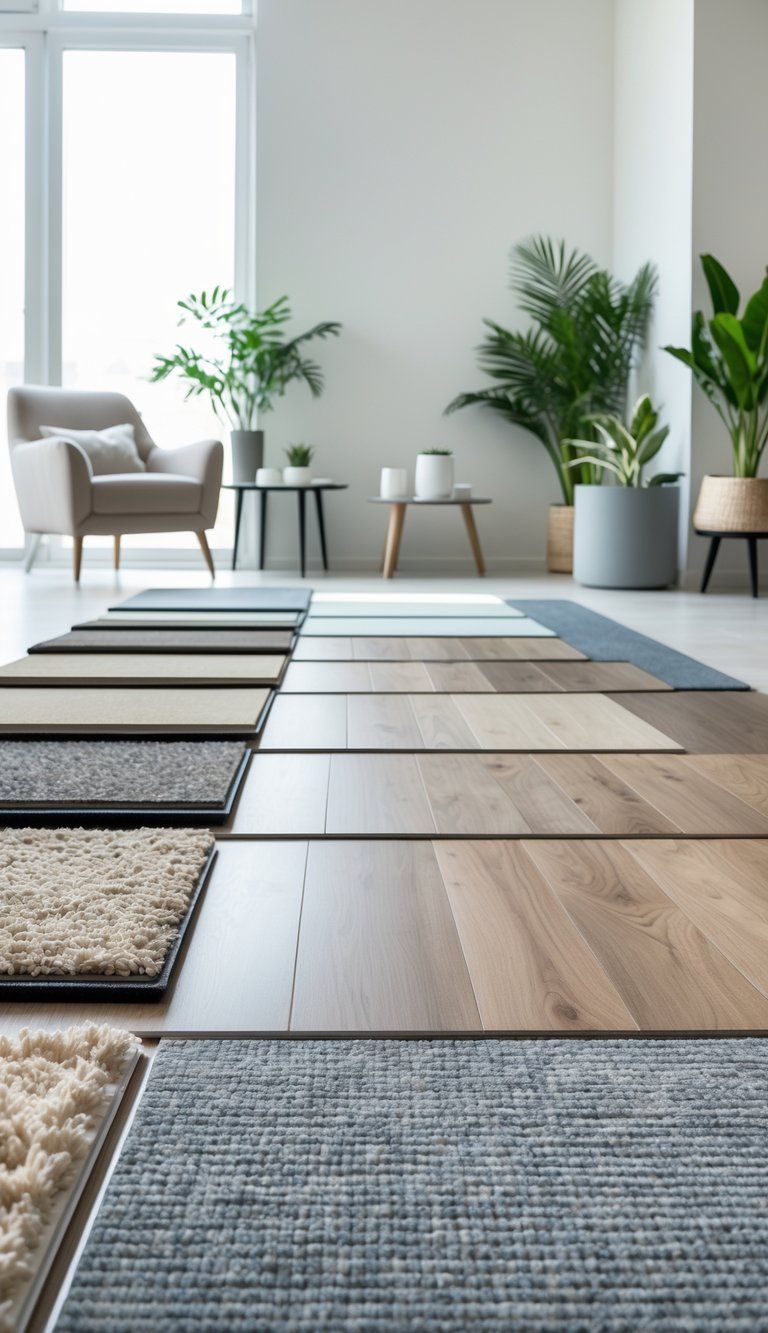
The right floor can turn a noisy room into a peaceful spot. Sound-absorbing materials help cut down on noise and add comfort underfoot. They’re a great fit for bedrooms, home offices, and living rooms.
Carpet and Carpet Tiles
Carpet remains one of the top choices for reducing sound at home. Wall-to-wall carpet absorbs up to 70% of airborne noise and makes a big difference with footsteps.
Pick carpet with a thick pad underneath if you want the most sound dampening. The pad’s thickness matters even more than the carpet itself.
Carpet tiles give you similar benefits but with more flexibility. Swap out damaged tiles instead of redoing the whole floor. They’re great for basements, playrooms, or home theaters.
Wool carpets naturally absorb sound, while synthetic options like nylon hold up well in busy areas. If you have allergies, low-pile carpets trap less dust and allergens.
Best rooms for carpet: Bedrooms, living rooms, home offices, and basements.
Area Rugs and Runners
Area rugs help quiet a room without the commitment of wall-to-wall carpet. They’re perfect if your hardwood, tile, or vinyl floors need a little help with sound.
Thicker rugs do a better job absorbing noise. Look for dense piles and rubber backing. Adding a cork or rubber pad underneath boosts sound absorption even more.
Runners work wonders in hallways and on stairs, cutting down on echoes from footsteps. Make sure they have non-slip backing to keep things safe.
Layering rugs can add depth to your look and improve acoustics. Try a bold rug over a larger, neutral one for extra style and sound reduction.
Quick tip: For best results, let your area rug stretch at least 6-8 inches beyond your furniture on all sides in seating areas.
Eco-Friendly and Healthy Flooring Options
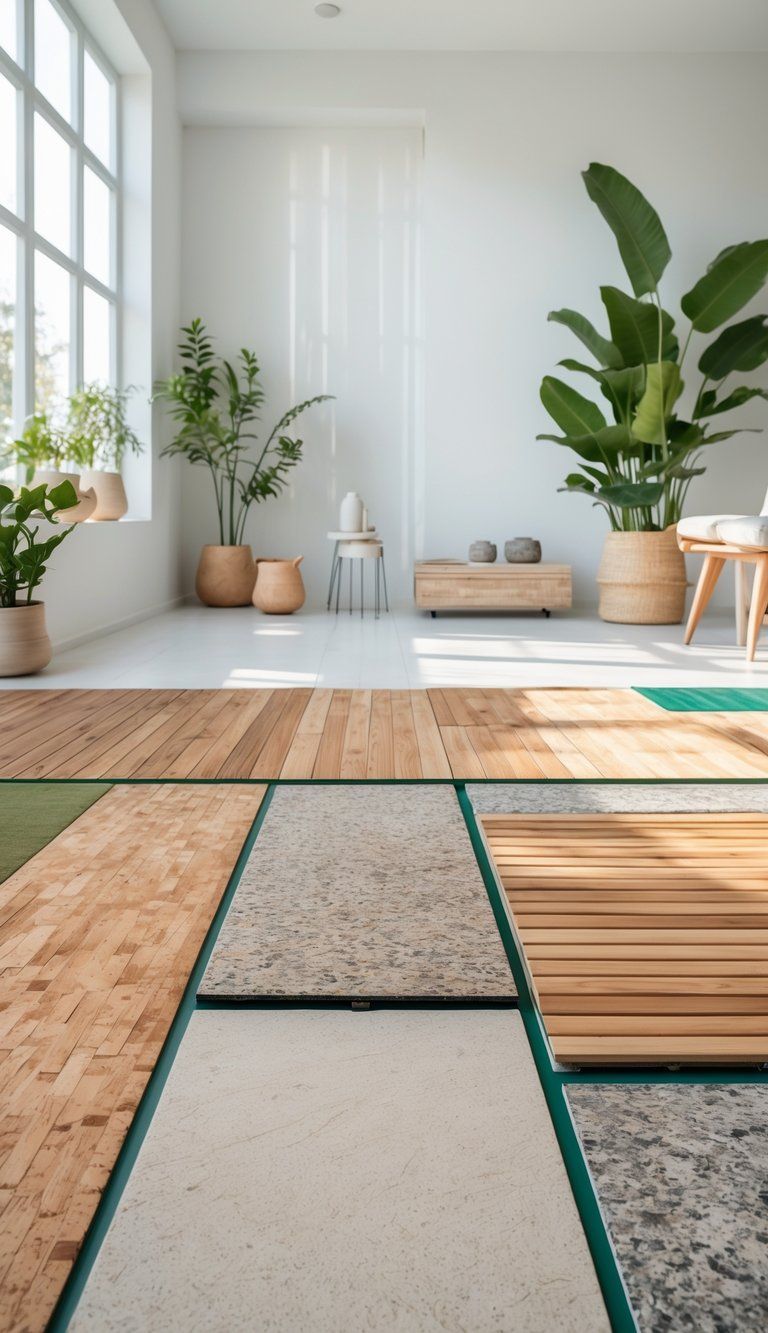
Choosing eco-friendly flooring can shrink your home’s environmental footprint and help create a healthier space. Plenty of sustainable options look great and work well without sacrificing performance.
Sustainable and Renewable Materials
Bamboo flooring stands out as a green pick since it matures in just 3-5 years, while hardwood trees take decades. That fast growth makes bamboo a smart, sustainable choice.
Cork flooring comes from the bark of cork oak trees. The bark grows back every nine years, so the tree stays healthy. Cork feels soft underfoot and even helps insulate your home, which might lower your energy bills.
Marmoleum (natural linoleum) uses linseed oil, pine resin, and wood flour on a jute backing. Unlike vinyl, it’s biodegradable and free of nasty chemicals. It’s also naturally antibacterial and hypoallergenic.
Reclaimed wood gives old timber a second life and cuts down on the need for new trees. Plus, the unique marks and patina give every piece a story.
Allergen and Air Quality Impacts
Low-VOC options make a big difference for healthy indoor air. Many eco-friendly floors rely on water-based finishes and natural materials that give off fewer volatile organic compounds than the usual flooring choices.
Engineered wood flooring works well for air quality when manufacturers use formaldehyde-free adhesives. If you want to be sure about responsible sourcing, check for products with Forest Stewardship Council (FSC) certification.
Rubber flooring that’s made from natural, not synthetic, materials stands up to wear and tear and keeps chemical emissions low. This type of flooring really shines in spaces where you need more cushioning or slip resistance.
Avoid laminate flooring if it contains a lot of formaldehyde, since it can keep releasing fumes for years. If you still want laminate, pick something labeled low-emission or CARB Phase 2 compliant.
Installation and maintenance matter, too. Go for eco-friendly adhesives and cleaners to help your flooring stay as healthy as possible.

